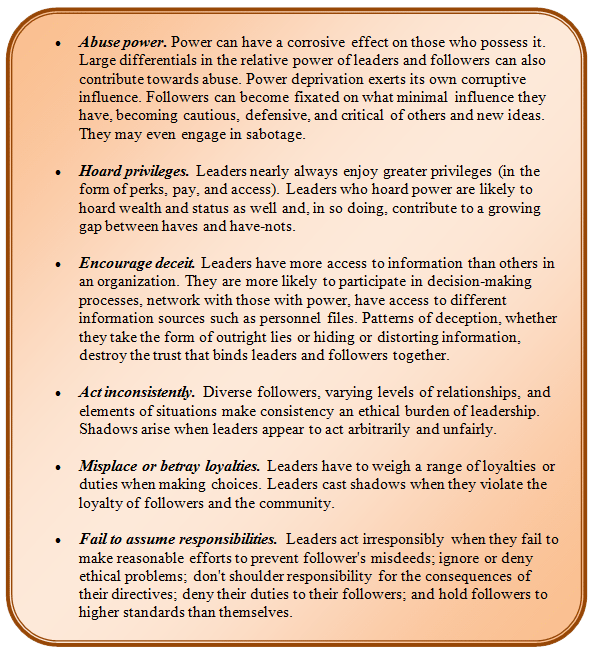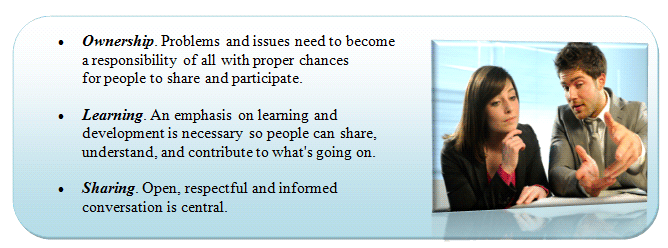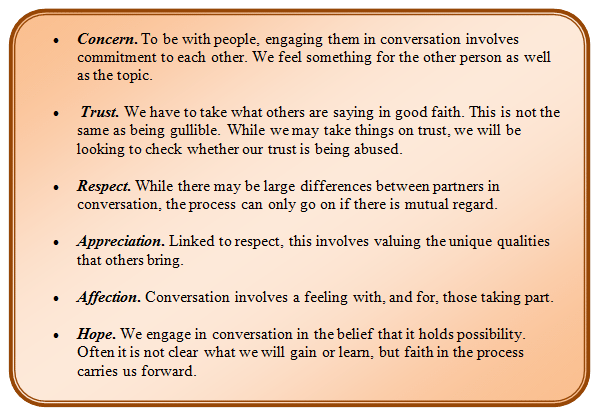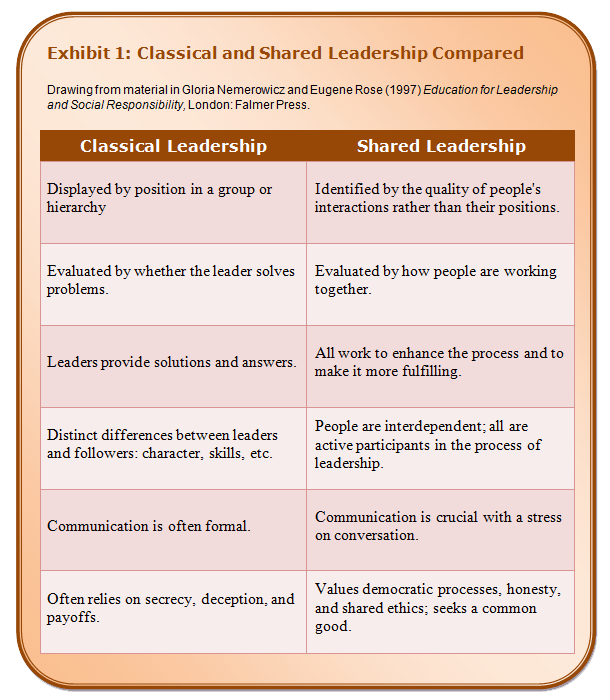SHARED LEADERSHIP
Unit Overview
Read and study the following unit. Answer the questions at the end of the unit based on the information that you have learned from the unit.

|
Shared leadership makes the following assumptions
|
A group functions more effectively when all its members accept responsibility for the work and life of the group. This shared sense of responsibility is also known as shared leadership. This doesn’t in any way diminish the need for skilled, effective team leaders. While most work teams will continue to make use of designated leaders, team effectiveness can be significantly enhanced by shared leadership, and the resources of all can be engaged. Anyone in the group can perform the role of leader.
Leadership can be explored as a social process – something that happens between people. It is not so much what leaders do, as something that arises out of social relationships. As such, it does not depend on one person, but on how people act together to make sense of the situations that face them. It is happening all the time.
Everyday Leadership
If we look at everyday life – the situations and groups we are involved in – then we soon find leadership. Friends deciding how they are going to spend an evening, families negotiating over housework – each involve influence and decision. However, such leadership often does not reside in a person. It may be shared and can move. In one situation, an individual may be influential because of expertise or position; in another, it can be someone completely different. What these people may be able to do is to offer an idea or an action that helps to focus or restructure the situation – and the way in which others see things.

Sometimes there may not even be one person we can readily label as leader – just a group working together to achieve what is wanted. Rather than people leading, it is ideals and ideas. We don't follow an individual; we follow the conversation. Through listening and contributing, thoughts and feelings emerge and develop. It is not the force of personality that leads us on, but the rightness of what is said. Other factors may also operate.
From this we can see that it is not our position that is necessarily important, but our behavior. The question is whether or not our actions help groups and relationships to work and achieve. Actions that do this could be called leadership – and can come from any group member. Many writers tend to talk about leadership as a person having a clear vision and the ability to make it real. However, as we have begun to discover, leadership lies not so much in one person having a clear vision as in our capacity to work with others in creating one.
We may also recognize the power of self-leadership, each of us trying to get the most out of our own resources. Some people have talked of this as the influence we exert on ourselves to achieve the self-motivation and self-direction we need to perform. Such self-motivation and self-direction can impact others.
The leadership process is part of our daily experience. We may lead others, ourselves, or be led. We plan our part in relationships and groups where it is always around. Sometimes there is an obvious “leader,” often there isn't, nor are there always obvious followers. The world is not neatly divided in this respect. Part of our responsibility as student leaders in the process is to work so those who may label themselves as followers come to see that they, too, are leaders. Leadership is encouraging others to realize their own leadership potential.
| Ethics We also want to take things a stage further. For something to qualify as “leadership” we must also make judgments about the quality of what happens. It should enrich the lives we all lead. Here we want to highlight two aspects. |
Leadership must be |
We want to include these ethical qualities so we can make proper judgments about leadership. For example, if we stay with a simple, technical definition such as leadership as the exercise of influence in a group context, then we can look at Hitler and say he was, in many respects, a great leader. He had a vision, was able to energize a large number of people around it, and develop the effectiveness of the organizations he was responsible for. However, as soon as we ask whether his actions were inclusive and elevating we come to a very different judgment. He was partly responsible for the death and exclusion of millions of people. He focused people's attention on the actions of external enemies, internal scapegoats, and false images of community while avoiding facing a deeper analysis of the country's ills. Hitler wielded power, but he did not lead. He played to peoples’ needs and fears. If he inspired people toward the common good of Germany, it was the good of an exclusive society destroying others.
We could go on. Hitler's failings weren't just moral. Hopefully, the point is made. Leadership involves making ethical as well as technical judgments.
Using the metaphor of shadow and light, leaders have power to illuminate lives of followers or to cover them in darkness as they cast shadows. Poor leaders may use their positions in the following negative ways to

|
Democratic Leadership and Shared leadership
Aspects of the approach we are exploring here are sometimes called democratic leadership. It involves people, and can foster a belief in democratic principles and processes such as self-determination and participation. These are concerns that we share.
For democratic leadership to develop, you need to pay special attention to three things. You need to encourage
 |
Ownership
Leadership is taking some form of responsibility in any given situation. There are some very practical reasons for encouraging people to own the problems facing them. For example, where the problem is non-routine and needs an unusual response, it is important to have the right information. Involving those with a stake in the situation gives a chance for insights to emerge. Further, the more people take on an issue or problem as theirs and involve themselves in thinking through responses, the more likely they are to act and to carry things through. They have an investment in making things happen. It is their solution, not somebody else's. In a lot of situations, we may simply comply with what a manager, parent, or friend tells us to do. It saves us thinking. More importantly, it allows us to blame them if things go wrong. Sometimes we just “buy-in” to a suggestion – we can see the sense of it, but don't commit to it. As a result, we are less likely to stick with it when the going gets tough. We can also still blame the suggestion-maker in some way – “I wish I'd never listened to you.” When we own a problem it becomes our responsibility. If things go wrong when trying to find a solution, we cannot blame others. For these reasons alone we may be very resistant to shouldering responsibility.
 |
We may also be frightened and lost. Sometimes the issue facing us is so complex or of such a scale that we don't know where to start. We may be worried about getting things wrong, or not understanding what the issues are, or adding to conflict. Faced by a crisis or an apparent problem, we may look for strong leadership. It may be through anxiety, hostility, or helplessness (to name just a few emotions) that we are ready to turn to those who seem to have an answer. There is a triple danger here. First, these powerful emotions may well push us to project all sorts of capacities onto “leaders” that they do not possess. Because they talk a good talk, or look the part, we may want to believe that they know what they are doing and have our interests at heart. Second, the desire to rid ourselves of uncertainties and worries can lead us to turn away from our responsibilities. It is so much easier if someone else can take on the worries. Third, we can overlook the extent to which we contribute to the situation. It may be our actions, or our opinions that are helping to make the crisis. |
The issue here is how we contain our distress enough to get over any initial hurdles. We need a breathing space. With friends, families and fellow workers we often turn to “a safe pair of hands” to achieve this. Safety here is less about being told what to do, as feeling that we have some sort of structure supporting or maintaining us. We need a safe environment in which our attentions are focused and we can begin to work on the problem. Within a team, for example, there may well be someone who is able to say something like, “I don't have the answers, but if we take things bit by bit, we may find a way through.” This is a classic way of holding the situation. Actions such as breaking things into smaller pieces and trying to slow the pace down a little help us put our brains into gear and put panic to one side.
We may also try to avoid taking responsibility for things because we are lazy or want others to do things for us. After all, if we own a problem then we will have to act at some point. Why bother exerting ourselves if we can sit back and let someone else take the strain? This takes us straight into the realm of ethical questions. Is it fair that someone should take a ride on the backs of others? Is it right to benefit from belonging to a group, teams, or organizations without making the fullest contribution we can?
Learning
To act for the best we need to be informed. Our actions have to be shaped by a good understanding of the situation and of the possibilities open to us. We also need to develop some very practical skills and to attend to our feelings. In short we need to deepen our understanding, develop, and share in this with others. Leadership entails learning. It means becoming wiser and more knowledgeable.
Wisdom is not something that we possess like a book or computer. It is a quality that appears in action. The people we describe as wise do not necessarily know a lot of things. They are not encyclopedias. Rather, they are able to reflect on a situation and, as likely or not, encourage others to join with them. Crucially they are also able to relate this to the sorts of practical actions that are right for the situation. In other words, wisdom is concerned with making choices about something that has to be done or not done. And to act wisely we must think and evaluate. This is more than cleverness. We must want, and be able, to make some sense of what life throws at us. Knowing about lots of different things is of little use if that knowledge cannot be related to the problem that is facing us at this moment.
| Yet there is something more at work here. Wisdom is wrapped up with morality. To be wise, we would argue, is also to have a care for people (including ourselves) and for how we may all live more fulfilling lives. If we are to think and to evaluate we must have standards by which to judge what we find. This means looking to what philosophers like Aristotle talked about as the good life. This involves having an understanding of the different things that need to come together if people are to flourish. There will be countless arguments about what this actually entails. People have different experiences of life and, as a result, see the world in contrary ways. Knowing this we should be ready to explore beliefs, hopes and feelings with each other. There is no monopoly on truth – but we do need to take a position. To act we must come to some decisions about what may help us to live fulfilled lives e.g., having food in our stomachs, a roof over our heads, a chance to contribute to society and so on. Some people argue that there is a hierarchy of needs around such matters – that we need to eat and have shelter before we look to other areas of fulfillment. Others disagree. Wisdom lies in not having fixed ideas here, but in taking a position and modifying it in the light of experience. We must have some humility – to be open to others, to experiences, and to criticism. | 
|
Some would argue that true leaders are educators. Their task is to work with communities to face problems and lead themselves rather than to influence people to agree to a particular position. They help to build environments in which people can reflect upon how they can help with solving problems and with achieving goals. Furthermore, there is a need to develop people's ability to make decisions, work together and think in ways that respect others.
| Sharing Alongside spreading ownership and cultivating learning we need to develop open and productive ways of sharing our thoughts and feelings. This isn't just so that we can make better decisions, but also so we can talk and be with others. Through this we may learn about them, ourselves, and find our place in the world. In short, this means developing conversations that involve people, deepen understanding and help us make sound judgments and decisions. Good conversation involves us in cooperating, thinking of each other's feelings and experiences, and giving each room to talk. The virtues it involves are central to building stronger and healthier communities and organizations. In good conversation, the topic takes over. It leads us, rather than us leading it. |
 |
How do we do this? We deliberate. This entails weighing up situations and coming to an understanding. Crucially, it also involves coming to decisions. This requires
 |
People need to be involved in ways that allow them to face-up to situations and take responsibility. Relationships, and how people feel about each other, often get in the way. Here leaders take on a special role. They can help people shift from focus on the topic to the processes they are going through and the feelings involved (and vice versa). All this can help build an environment in which there is respect and sharing.
Uncovering what it is that people want to talk about, defining issues, weighing up alternatives, and making decisions on ways forward are not easy. They do not happen in some simple step-by-step fashion. There is ebb and flow. Rushing towards a decision might bring some sense of achievement but can crowd out the richness of dialogue. Going with the flow can allow people the space and time to make wise choices. Balance this with a concern for focus, relationships and feelings, and the virtues of conversation, and we open up a space where wisdom can flourish.
In Conclusion
In previous units, we have seen some deeply contrasting views of leadership. Exhibit 1 compares classical and shared leadership.
Presented like this, we can see how easy it is for people to misunderstand each other. When we talk of leadership, are we looking for position or process; individual activity or social interaction; orders or conversation? What one person means can be very different to another.
 |
Four pitfalls are associated with shared leadership.
|
This said, thinking about leadership in these ways allows you to begin to get to the heart of what it may involve – and how you may respond.
When Leadership is Not Needed
Leadership is not always needed in all situations. In fact, when it is not needed, attempts to lead are irritating at best and may result in the would-be leader's advances being rejected.

